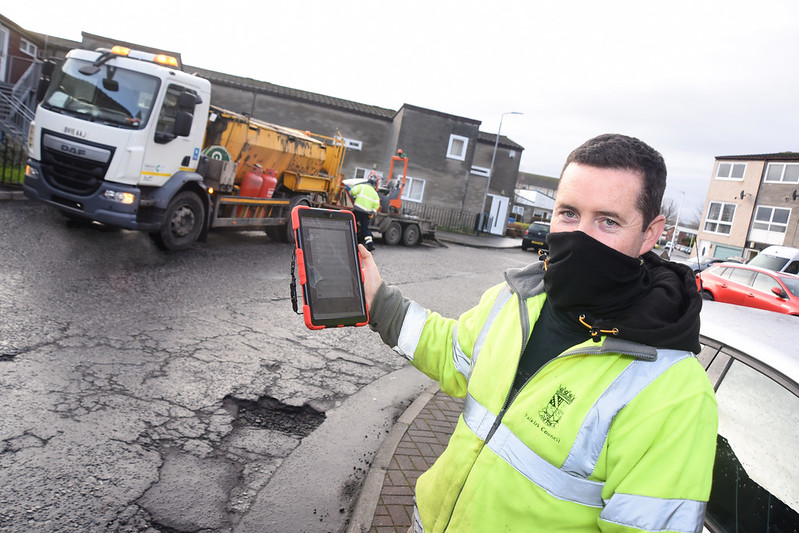
Pictured: Alan Brodie, Roads Foreperson, uses the new system while out on a job.
Potholes … a source of irritation for motorists and a headache for our Roads & Grounds service.
Last year we received 11,037 reports of potential holes in our road network. These reports came in via the Contact Centre or a form on our website before going through a manual, paper-based and lengthy process of inspection and, where required, repair.
Now, thanks to new technology – and the expertise of the Council’s Web Team - that process has been simplified, making reporting and repairing potholes quicker and easier than ever before.
To report a road defect, visit the Council’s
Report it today webpage. You can then track the progress of your report in real-time. An automatic email will be issued confirming if and when work has been carried out.
Swapping paper for digital tools
Potholes form when moisture seeps into the lower layers of asphalt through existing small cracks in a road surface. As temperatures reduce in winter, moisture can freeze and then thaw, expanding and contracting and weakening the cracks. Add the pressure of traffic on top … and the holes break apart to form potholes.
Gary Neill, Area Roads Engineer, said:
“We need to modernise how our service operates and that includes how we deal with reported road defects such as potholes. Working closely with the Web Team, we’ve been able to create a cloud-based system that fully automates the customer journey and takes a wide range of our paper-based processes online.
“Now our Roads Inspectors and Repair Teams can communicate with each other digitally, using tablets on site to send everything from repair instructions to writing off the job once repairs are complete. No more paper processes, just slick and quick repairs using the latest technology.”
As well as bringing benefit to the Roads & Grounds service, the new system aims to reduce the number of calls the Contact Centre receives. It also provides frontline employees with equity of access to digital tools and information, making it easier to report Health & Safety incidents and view payslips and council policies online.
Building a road to transformation
The Digital Solutions for Design, Roads and Transport project identified and delivered the new system. Led by Gary, the project – which introduced automated gritting and the Council’s interactive gritting map last year - is helping to drive forward the Council’s digital agenda by embracing new technology to improve service delivery.
However, none of these developments would have been possible without the help of the Web Team.
Gary said:
“Having a close working relationship with the Web Team has kept our project on track, delivering new tools that are transforming how we work and how communities interact with our service. That relationship has been strengthened thanks to the introduction of Microsoft Teams. By setting up a Teams working group, everyone involved had an opportunity to input their thoughts and ideas quickly and easily, and it allowed us to work together to overcome issues that arose.”
The Digital Solutions for Design, Roads and Transport project is part of the wider Transformation of Roads & Grounds, one of 23 Council of the Future projects that aim to modernise and improve services and help deliver on the Council’s three new corporate priorities - Communities, Enterprise, and Innovation.